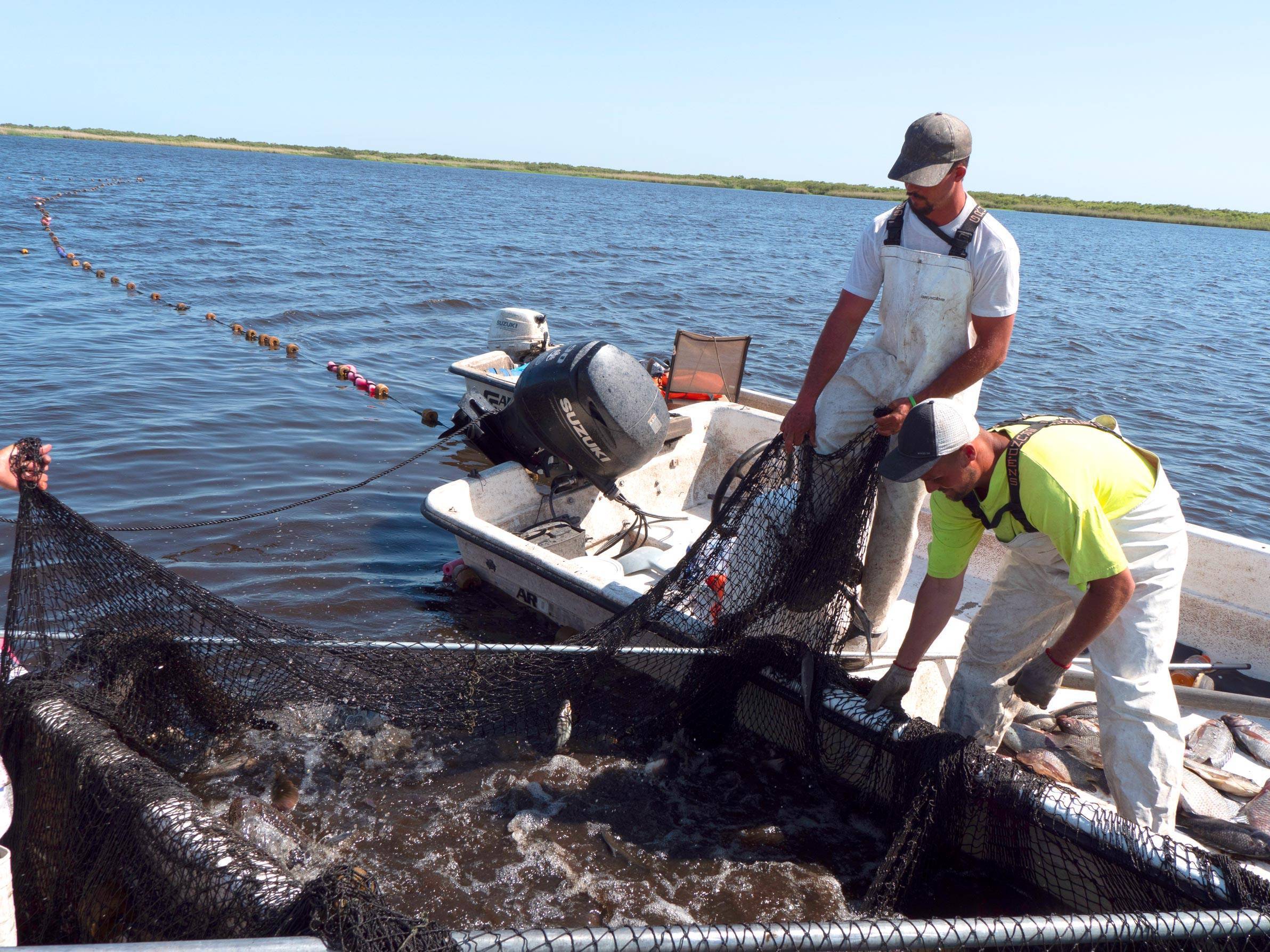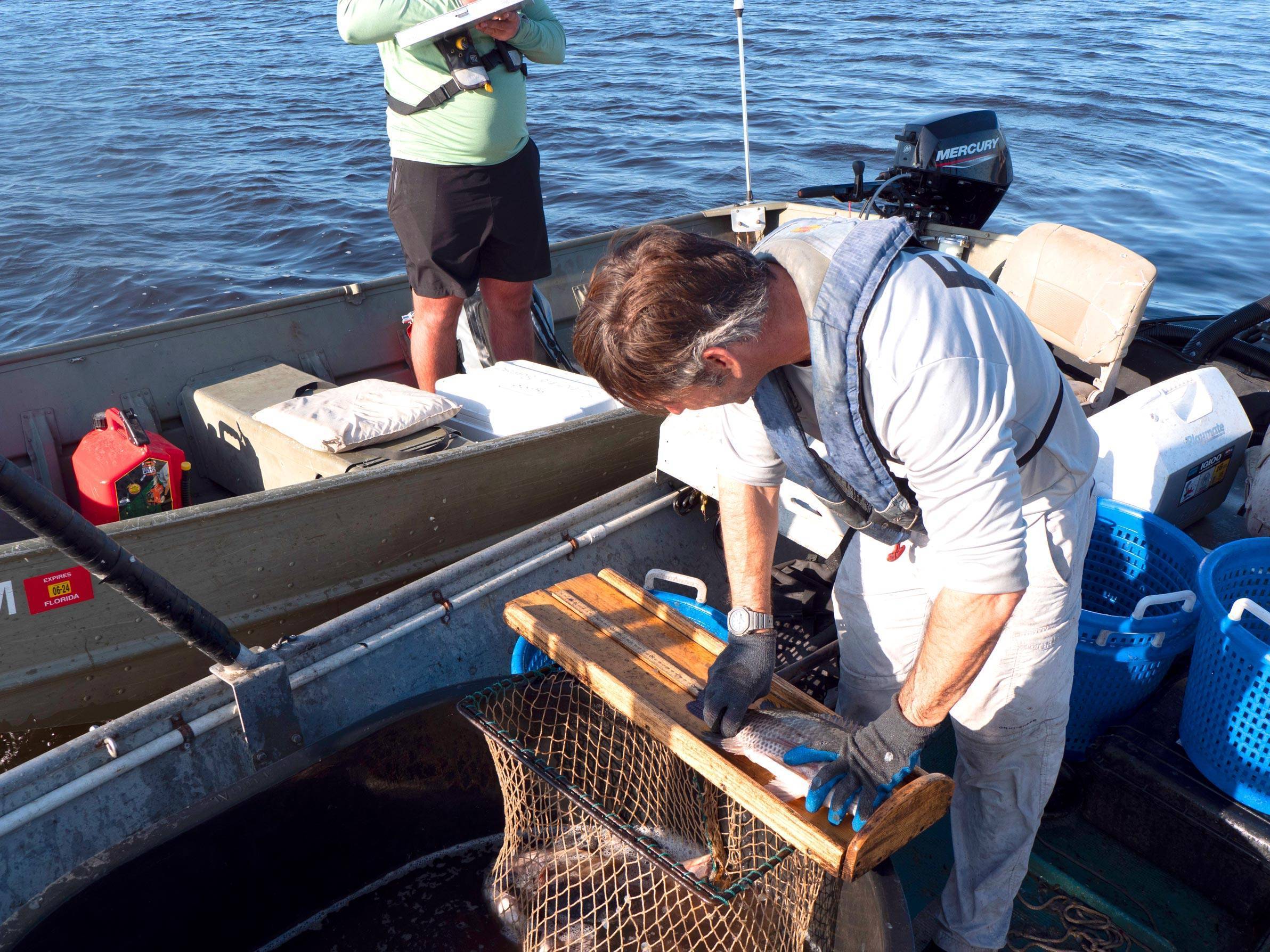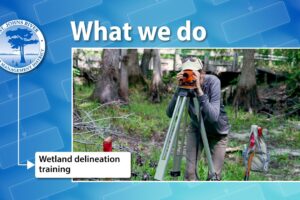District scientists partner with commercial fishermen to improve water quality
June 29, 2023
Fishermen haul in a net full of exotic tilapia and armored catfish as part of a project to reduce the cycling of nutrients that cloud the waters of Lake Poinsett.
One warm Wednesday in early May, the Wadley family went fishing. It’s what they do nearly every day of the week — they’re commercial fishermen and their business is a family one. Three generations are on the lake today scattered among four boats. As they plan the day, Taren Wadley, the family matriarch, recounts the stories of her parents and their parents, and the long lineage of Floridians making a living by fishing. Their struggles and successes are interwoven with Florida’s droughts, hurricanes and the history of water management.
Today, the Wadleys are at Lake Poinsett just west of the city of Cocoa. It’s one of the many lakes along the St. Johns River. Again, water management brings the family here. They’ve come as part of a project the St. Johns River Water Management District started to improve water quality along the river.
Steve Miller, an environmental scientist with the District, initiated the project. A few years ago, he and other scientists from the District and the Florida Fish and Wildlife Conservation Commission (FWC) watched with concern as signs of tilapia and armored catfish increased in the lakes and headwaters of the St. Johns River. These invasive fish appear to be on the rise in the river’s upper basin — to the extent that tilapia’s shoreline nests are visible in the satellite photos on Google Earth. “We think they’ve had a major impact on the fish community,” he explains. “Tilapia stir up sediment as they nest and impact how nutrients cycle — they could be having an impact on water quality, especially at such a high population.”
The Wadleys spend an hour or so scouting the lake looking for fish before they set out their haul seine — a fishing net that’s 19 feet in width and 1,000 yards in length. Stretched out it would be over half a mile long. A net this size needs (and has) its own boat, towed along like a wagon. They lay the net in the water creating a giant cylinder: a weighted line along one edge allows the net to sink to the bottom, keeping any fish from escaping underneath while pool noodles float to the top to suspend the top edge. But it’s windy, and the floats are constantly pushed around so it takes several hours to set out the seine. Taren, her brother-in-law, and her son walk through chest-deep water that’s cold from a recent rain. By the time they finish, they’ve surrounded 36 acres worth of lake and captured every fish, turtle and alligator that had been swimming within. They start to pull the net together, yelling to each other over the wind. The alligators realize they’re trapped and start thrashing and fighting against the net.
The Wadleys are only interested in the invasive tilapia and hoplos (a type of armored catfish). Their compensation for their efforts today comes from what they sell to a fish house. But along with the tilapia they’ve captured bass and bluegill — both good game fish — and plecos, another invasive armored catfish. The District permit allows them to keep only the tilapia and the armored catfish. Everything else — the bluegill, the bass, the turtles and the alligators — is sorted out by hand (as much as you can sort an alligator) and returned to the lake. Even though the plecos can’t be sold, the Wadleys take them. It’s a condition of their permit. Ultimately, these fish will end up in the landfill.
“Our main goal is nutrient removal,” explains Randy Fink, an environmental scientist at the District who works with Miller. He’s out today monitoring and collecting data on the harvest and mapping the area covered by the haul seine.
Removing tilapia and armored catfish benefits water quality directly by removing the nutrients stored in the bodies of the fish. These fish live at the bottom of the lake feeding on algae and aquatic plants. Excess nutrients — specifically nitrogen and phosphorus — spur the growth of algae. As the tilapia and armored catfish eat the algae, those nutrients are stored in their bodies and can’t immediately be used to feed more algae.
“Nutrient removal by harvesting tilapia and armored catfish is an immediate benefit from the program,” explains Reid Hyle, a fisheries biologist with the Florida Fish and Wildlife Conservation Commission (FWC). FWC issues the permits to do the nutrient removal project. “But we are also concerned about the direct impact on habitat caused by tilapia and plecos when they become too abundant.” Because a haul seine captures most of the fish in a given area, the project helps FWC better understand the entire fish community. Hyle is here to collect data on the catch. As the Wadleys unloaded the net, Hyle asked for a scoop of fish — he measured each fish, recording the data by species. The game fish went back into the lake, the tilapia and plecos went to the Wadleys. “We’re able to get a better understanding of the abundance of nonnative fish and game fish in the St. Johns,” says Hyle.
Miller began the project as a pilot project in 2022 on Lake Winder. “We thought it could be a cost-effective way to remove nutrients,” says Miller. “Since tilapia can be sold by the fisherman, the only expense for the District is the staff costs associated with monitoring and collecting data.” The project is turning up surprising information.
“The first time we pulled the net, we didn’t know what we were going to find,” says Miller. “It was a shock — they were there until 3 a.m.” Even the fishermen were overwhelmed. “They had to call in a semi-truck to haul them all away,” says Miller. Over the course of the three-day project, the fisherman pulled 23,000 lbs. of tilapia (the equivalent of 144 lbs. of phosphorus pollution) from the lake. That’s the equivalent amount of fertilizer that would cover 10 football fields.
And that’s only the nutrient removal benefits. Removing tilapia and armored catfish helps with nutrient cycling within the lake. Tilapia build volcano-shaped nests on the lake bed, digging up sediment to reach the bare sandy soil beneath. The stirred-up sediment decreases water clarity. Between the disturbance caused by the tilapias’ year-round nest building and the increasing cloudiness of the water, tilapia are affecting the submerged aquatic vegetation, a key to healthy aquatic environments. The project expanded this year to Lake Poinsett and Lake Florence.
“We’re finding that 85% or more of the biomass in the lakes is invasive fish,” says Miller.
“The abundance of tilapia is going to have an effect on the rest of the ecosystem,” says Hyle. “We haven’t quantified what that is yet, but both here and downstream these fish are likely affecting water quality and aquatic food webs.” The project is helping FWC determine if invasive fish can be managed with harvests and how frequently they would need to happen to have a significant impact on the tilapia population. Historically, these fish have been kept in check by cold temperatures farther north, but climate change is shifting their population limits. Tilapia, tolerant of higher levels of salinity, can be found all the way to the northern reaches of the St. Johns River in Jacksonville.
The plecos also impact the ecosystem. They burrow to make their nests, generally along the shorelines, but on Lake Florence, harvested a few weeks earlier than Lake Poinsett, Miller found them burrowing in the lake bottom. “This is the first time I’ve seen it,” he says. “We were walking across the bottom and sinking into the sediment as the burrows collapsed,” he says. “I was hoping there wasn’t an armored catfish underneath me.” This burrowing causes erosion and stirs up muck, affecting water quality. Plecos don’t differentiate between shorelines and levees. “Plecos can destabilize levees, damaging the structures we use for flood control. Plecos increase our maintenance costs,” says Miller.
The sun was setting at Lake Poinsett by the time the Wadleys finished pulling the tilapia and plecos out of the net. After a tense hour of sorting fish from gators, all five alligators ended up back in the lake. That day the Wadleys pulled about 7,000 lbs. of tilapia out of the lake. They would come back over the next few weeks to harvest again at Lake Poinsett and Lake Winder. “There’s only a narrow window of time we can do the tilapia harvests,” explains Miller. American shad spawn in the St. Johns when the water temperature is cooler, so Miller must wait until the temperatures are warming and the highly protected shad are done spawning to harvest tilapia, but before the summer rains would increase the volume in the lakes and the tilapia head into the floodplains.
Though the season may be limited, Miller sees the potential in continuing the program going forward. “We know we get cost-effective quantifiable nutrient removal right now,” he says. “Furthermore, the harvests help our partners better understand fish stocks in the St. Johns and explore tools to manage invasive fish populations to the benefit of river habitat and sport fisheries.”







